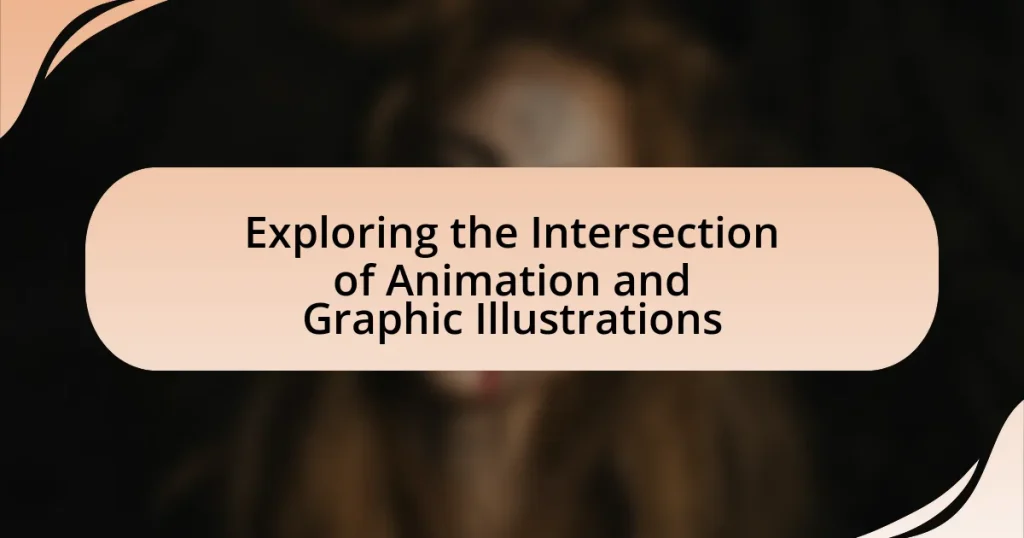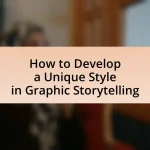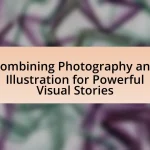The article explores the intersection of animation and graphic illustrations, highlighting their shared visual storytelling techniques and complementary roles in enhancing narrative engagement. It discusses key differences between the two mediums, the techniques commonly used, and how graphic illustrations can enhance animation projects. The article also addresses the importance of this intersection in modern design, its applications across various industries, and the skills necessary for artists to succeed in both fields. Additionally, it examines best practices for collaboration and resources available for skill improvement, emphasizing the impact of combining these disciplines on audience engagement and perception.
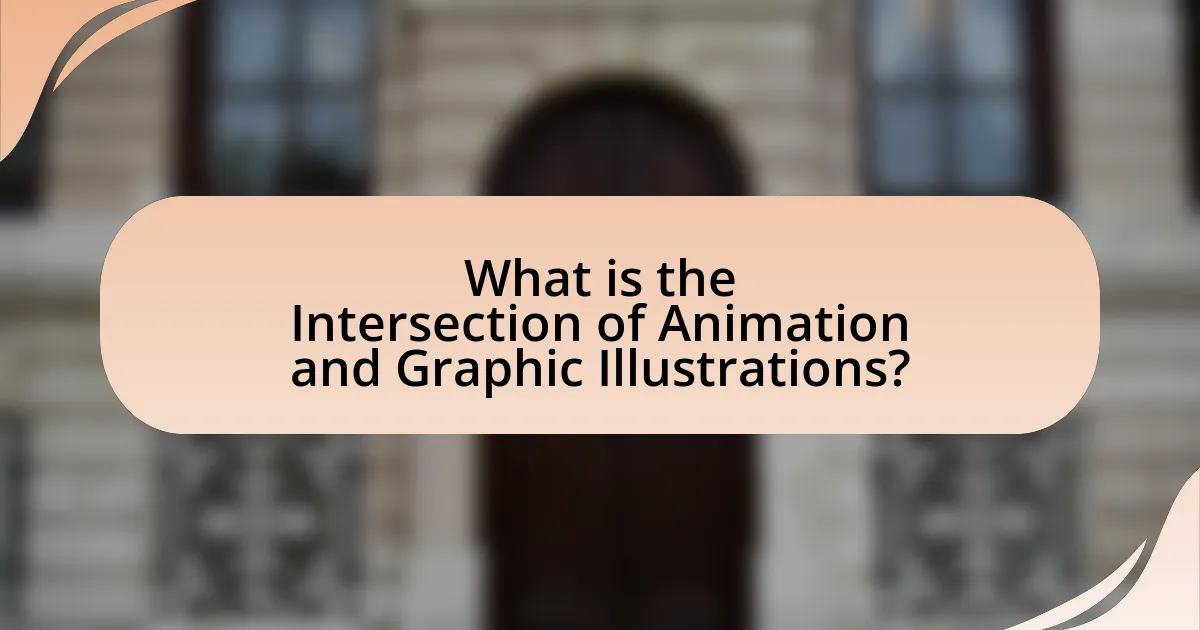
What is the Intersection of Animation and Graphic Illustrations?
The intersection of animation and graphic illustrations lies in their shared use of visual storytelling techniques to convey ideas and emotions. Both mediums utilize design principles, color theory, and composition to create engaging visuals, but animation adds the dimension of movement, enhancing the narrative experience. For instance, animated illustrations can bring static images to life, allowing for dynamic storytelling that captures audience attention more effectively than traditional graphic illustrations alone. This synergy is evident in various applications, such as animated infographics, where complex data is simplified through both illustration and motion, making information more accessible and engaging.
How do Animation and Graphic Illustrations Complement Each Other?
Animation and graphic illustrations complement each other by enhancing storytelling and visual engagement. Animation brings static illustrations to life, adding movement and dynamism that can convey emotions and actions more effectively. For instance, animated infographics can present complex data in a more digestible format, making it easier for audiences to understand and retain information. Additionally, graphic illustrations provide the foundational visual elements that animation builds upon, ensuring a cohesive aesthetic and thematic representation. This synergy is evident in various media, such as animated films and educational videos, where the combination of both forms creates a richer viewer experience.
What are the key differences between Animation and Graphic Illustrations?
Animation involves creating moving images through a sequence of frames, while graphic illustrations are static visual representations. The primary distinction lies in motion; animation brings illustrations to life through movement and timing, often utilizing techniques like frame-by-frame animation or computer-generated imagery. In contrast, graphic illustrations focus on conveying messages or concepts through still images, employing techniques such as drawing, painting, or digital design. This difference in dynamic versus static representation is fundamental, as animations often require additional skills in timing and storytelling, while graphic illustrations emphasize composition and visual impact.
How can Graphic Illustrations enhance Animation projects?
Graphic illustrations enhance animation projects by providing a visually compelling foundation that enriches storytelling and character development. These illustrations serve as a blueprint, allowing animators to create more dynamic and engaging visuals that resonate with audiences. For instance, a study by the Animation Guild highlights that projects incorporating graphic illustrations often achieve higher viewer retention rates, as the unique artistic styles capture attention more effectively than traditional animation alone. This synergy between graphic illustrations and animation not only elevates the aesthetic quality but also deepens the emotional impact of the narrative, making the overall experience more immersive for viewers.
Why is the Intersection Important in Modern Design?
The intersection of animation and graphic illustrations is important in modern design because it enhances visual storytelling and user engagement. By combining dynamic elements of animation with the static appeal of graphic illustrations, designers create more immersive experiences that capture attention and convey messages effectively. Research indicates that animated content can increase user retention by up to 80%, demonstrating its effectiveness in communication. This synergy allows for innovative design solutions that resonate with audiences, making the intersection a crucial aspect of contemporary design practices.
What role does this intersection play in storytelling?
The intersection of animation and graphic illustrations plays a crucial role in storytelling by enhancing visual engagement and emotional resonance. This combination allows creators to convey complex narratives through dynamic imagery and expressive characters, making stories more accessible and relatable to audiences. For instance, animated illustrations can depict movement and emotion in ways that static images cannot, thereby deepening the viewer’s connection to the narrative. Research indicates that visual storytelling can improve retention and understanding of information, as seen in studies showing that people remember 65% of visual content three days later, compared to only 10% of text. This demonstrates the effectiveness of integrating animation with graphic illustrations in storytelling.
How does it influence audience engagement and perception?
Animation and graphic illustrations significantly enhance audience engagement and perception by creating visually stimulating content that captures attention. Research indicates that dynamic visuals, such as animations, can increase information retention by up to 65% compared to static images, as they facilitate a more immersive experience. This heightened engagement leads to improved emotional responses, making the content more relatable and memorable. Furthermore, studies show that audiences are more likely to share animated content, increasing its reach and impact. Thus, the integration of animation and graphic illustrations effectively influences how audiences interact with and perceive the material presented.
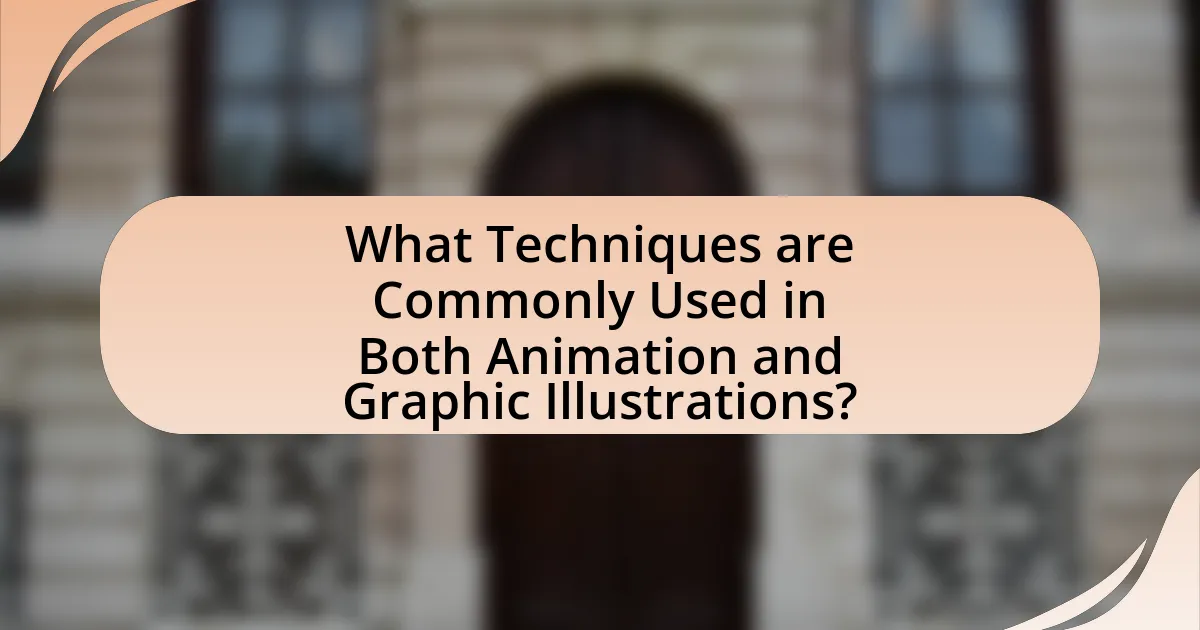
What Techniques are Commonly Used in Both Animation and Graphic Illustrations?
Common techniques used in both animation and graphic illustrations include character design, color theory, and composition. Character design involves creating visually appealing and relatable characters, which is essential in both fields for storytelling and engagement. Color theory is crucial as it influences mood and perception, guiding the audience’s emotional response. Composition refers to the arrangement of visual elements, ensuring clarity and focus, which is vital for effective communication in both animation and illustrations. These techniques are foundational, as they enhance visual storytelling and audience connection across both mediums.
How do Artists Blend Techniques from Both Disciplines?
Artists blend techniques from both animation and graphic illustrations by integrating visual storytelling elements with static imagery. This fusion often involves using animation principles, such as timing and movement, to enhance the dynamism of graphic illustrations, creating a sense of life and engagement. For instance, artists may apply frame-by-frame animation techniques to illustrate motion in a still image, or utilize digital tools to create interactive illustrations that respond to user input, thereby merging the two disciplines effectively. This approach is supported by the increasing use of software like Adobe After Effects and Procreate, which allow for seamless transitions between static and animated forms, demonstrating the practical application of blending these artistic techniques.
What are the most effective tools for creating hybrid works?
The most effective tools for creating hybrid works that combine animation and graphic illustrations include Adobe After Effects, Blender, and Procreate. Adobe After Effects is widely recognized for its powerful animation capabilities, allowing users to create intricate motion graphics and visual effects. Blender, an open-source 3D creation suite, supports both 2D and 3D animation, making it versatile for hybrid projects. Procreate, primarily a digital illustration app, offers animation features that enable artists to bring their illustrations to life seamlessly. These tools are validated by their extensive use in the industry, with Adobe After Effects being a standard in animation studios, Blender being utilized in various award-winning films, and Procreate gaining popularity among illustrators for its user-friendly interface and robust features.
How does color theory apply to both Animation and Graphic Illustrations?
Color theory is fundamental in both animation and graphic illustrations as it governs how colors interact, evoke emotions, and convey messages. In animation, color choices can influence the mood of a scene, guide viewer attention, and enhance storytelling; for example, warm colors often create a sense of excitement or warmth, while cool colors can evoke calmness or sadness. In graphic illustrations, color theory helps in creating visual harmony and contrast, ensuring that designs are aesthetically pleasing and effectively communicate the intended message. The use of complementary colors can make elements stand out, while analogous colors can create a cohesive look. Studies in color psychology support these applications, showing that colors can significantly affect human perception and emotional response, thereby validating the importance of color theory in both fields.
What are the Challenges Faced When Merging Animation and Graphic Illustrations?
The challenges faced when merging animation and graphic illustrations include maintaining visual consistency, ensuring fluid motion, and addressing technical limitations. Visual consistency is crucial as differing styles can create a disjointed experience; for instance, a flat graphic illustration may clash with a 3D animated element. Fluid motion is essential for seamless transitions, and achieving this often requires advanced animation techniques that can be complex to implement. Technical limitations, such as software compatibility and rendering capabilities, can hinder the integration process, making it difficult to achieve the desired quality. These challenges necessitate careful planning and execution to create a cohesive final product.
How can artists overcome technical limitations?
Artists can overcome technical limitations by leveraging digital tools and software that enhance their creative capabilities. For instance, programs like Adobe After Effects and Blender provide advanced features that allow artists to create complex animations and illustrations without being hindered by traditional media constraints. Additionally, online tutorials and communities offer resources for skill development, enabling artists to learn new techniques and improve their proficiency with these tools. Research indicates that artists who engage with technology and continuous learning are more likely to innovate and push the boundaries of their work, as seen in the rise of digital art forms that blend animation and graphic illustrations effectively.
What are common misconceptions about the integration of these two fields?
Common misconceptions about the integration of animation and graphic illustrations include the belief that they are entirely separate disciplines and that animation is merely a series of illustrations. In reality, animation often relies heavily on graphic illustrations as foundational elements, where static images are transformed into dynamic sequences through movement and timing. Furthermore, many assume that only specialized animators can create animated content, overlooking the fact that graphic illustrators can effectively contribute to animation by providing the visual assets and storytelling elements. This integration enhances creativity and allows for a more cohesive visual narrative, as evidenced by successful projects in film and advertising that blend both fields seamlessly.
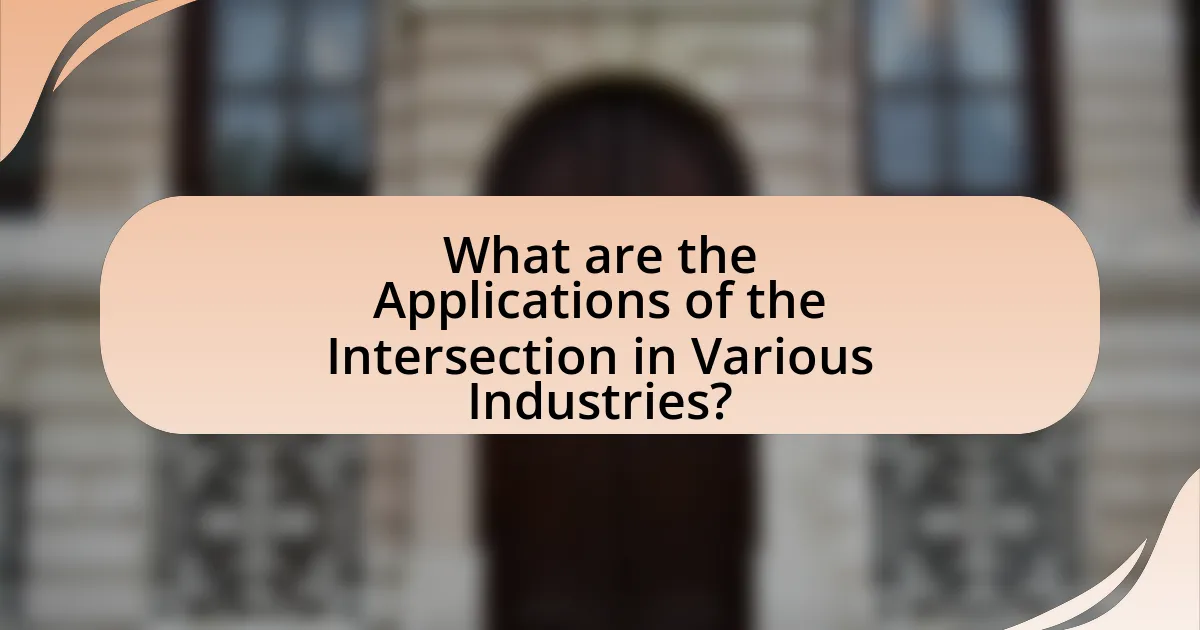
What are the Applications of the Intersection in Various Industries?
The intersection of animation and graphic illustrations has diverse applications across various industries, including entertainment, advertising, education, and healthcare. In the entertainment industry, animated graphics enhance storytelling in films and video games, creating immersive experiences for audiences. Advertising utilizes animated illustrations to capture attention and convey messages effectively, often leading to higher engagement rates; for instance, animated ads can increase click-through rates by up to 300%. In education, animated graphics facilitate learning by simplifying complex concepts, making them more accessible to students; studies show that visual aids can improve retention by 65%. In healthcare, animations are used to explain medical procedures and conditions, improving patient understanding and compliance. These applications demonstrate the significant impact of combining animation and graphic illustrations across multiple sectors.
How is this intersection utilized in Marketing and Advertising?
The intersection of animation and graphic illustrations is utilized in marketing and advertising to create engaging visual content that captures audience attention and enhances brand storytelling. This combination allows brands to convey complex messages in a simplified and entertaining manner, increasing viewer retention and emotional connection. For instance, animated infographics can present data in a visually appealing way, making it easier for consumers to understand and remember key information. According to a study by Wyzowl, 84% of consumers say they’ve been convinced to buy a product or service by watching a brand’s video, highlighting the effectiveness of animated content in driving consumer behavior.
What are successful case studies that illustrate this integration?
Successful case studies illustrating the integration of animation and graphic illustrations include the collaboration between Pixar and Disney, particularly in films like “Toy Story,” where 3D animation is seamlessly blended with artistic design elements. This integration has led to significant advancements in visual storytelling, as evidenced by “Toy Story” becoming the first entirely computer-animated feature film, grossing over $373 million worldwide. Another notable example is the use of animated infographics by companies like Google, which effectively combine data visualization with animation to enhance user engagement and understanding, demonstrated in their “Year in Search” videos that attract millions of views annually. These case studies highlight the successful fusion of animation and graphic illustrations, showcasing their impact on entertainment and information dissemination.
How do brands leverage Animation and Graphic Illustrations for storytelling?
Brands leverage animation and graphic illustrations for storytelling by creating engaging visual narratives that simplify complex messages and enhance emotional connections with their audience. These visual elements capture attention and convey brand values effectively; for instance, animated explainer videos can illustrate product features in a concise manner, making them more memorable. Research indicates that visuals are processed 60,000 times faster than text, which underscores the effectiveness of animation and illustrations in communication. Additionally, brands like Airbnb and Dropbox utilize animated graphics to create relatable stories that resonate with users, thereby increasing brand loyalty and engagement.
What Role Does the Intersection Play in Education and Training?
The intersection of animation and graphic illustrations plays a crucial role in enhancing education and training by facilitating visual learning and engagement. This combination allows educators to present complex concepts in a more digestible format, making information easier to understand and retain. Research indicates that visual aids can improve learning outcomes; for instance, studies show that learners retain 65% of information when paired with relevant visuals, compared to only 10% when presented with text alone. By integrating animation with graphic illustrations, educators can create dynamic content that captures attention and fosters a deeper understanding of the subject matter.
How can educators incorporate both disciplines into their curriculum?
Educators can incorporate both animation and graphic illustrations into their curriculum by designing interdisciplinary projects that require students to create visual narratives. For instance, a project could involve students developing a short animated film that utilizes graphic illustrations to convey a story, thereby merging the two disciplines effectively. Research indicates that integrating visual arts into education enhances creativity and critical thinking skills, as shown in studies like “The Impact of Arts Education on Student Achievement” by the Arts Education Partnership, which highlights improved academic performance in students engaged in arts-based learning. This approach not only fosters technical skills in both animation and illustration but also encourages collaboration and innovation among students.
What skills are essential for students to master in this area?
Students must master technical skills in digital illustration, animation principles, and storytelling to excel in the intersection of animation and graphic illustrations. Proficiency in software such as Adobe Illustrator and After Effects is crucial, as these tools are industry standards for creating high-quality visuals. Understanding animation principles, including timing, spacing, and movement, enhances the effectiveness of illustrations in conveying narratives. Additionally, strong storytelling skills enable students to create compelling visual narratives that engage audiences. These skills are supported by industry demand; for instance, the Bureau of Labor Statistics projects a 4% growth in employment for multimedia artists and animators from 2019 to 2029, highlighting the importance of these competencies in the job market.
What Best Practices Should Artists Follow When Exploring This Intersection?
Artists should prioritize a cohesive visual style when exploring the intersection of animation and graphic illustrations. This involves developing a consistent color palette, typography, and character design that aligns with the narrative and emotional tone of the work. Research indicates that a unified aesthetic enhances audience engagement and comprehension, as seen in successful projects like “Spider-Man: Into the Spider-Verse,” which utilized a distinct blend of animation techniques and graphic styles to create a unique viewing experience. Additionally, artists should experiment with motion to enhance storytelling, as dynamic elements can bring illustrations to life and convey emotions more effectively.
How can artists effectively collaborate across disciplines?
Artists can effectively collaborate across disciplines by establishing clear communication and shared goals from the outset. This approach ensures that each artist’s unique skills and perspectives are integrated into the project, fostering creativity and innovation. For instance, a study published in the Journal of Creative Behavior highlights that interdisciplinary teams that engage in regular dialogue and feedback sessions produce more cohesive and original work. By utilizing collaborative tools and platforms, artists can streamline their workflow and maintain alignment throughout the creative process, ultimately enhancing the quality of the final product.
What resources are available for artists looking to improve their skills in both areas?
Artists looking to improve their skills in animation and graphic illustrations can utilize online platforms such as Skillshare and Udemy, which offer a variety of courses tailored to both disciplines. These platforms provide structured learning paths, allowing artists to enhance their technical skills through video tutorials and hands-on projects. Additionally, resources like Adobe Creative Cloud provide industry-standard software tools essential for both animation and graphic design, enabling artists to practice and apply their skills effectively. Furthermore, communities on social media platforms like Instagram and Behance allow artists to share their work, receive feedback, and learn from peers, fostering a collaborative environment for skill development.
